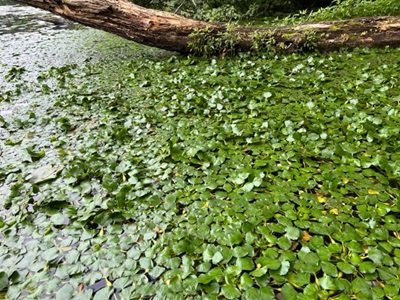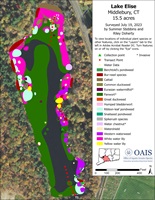
Invasive water chestnut patch found in 2023.
Lake Elise, Middlebury - 2023
2023 Aquatic Plant Map of Lake Elise
Lake Elise is a 15.5-acre lake downstream from Lake Quassapaug in Middlebury, Connecticut. It has a dam on the southern end of the lake and a maximum depth of around 2.5 meters. The lake and the surrounding land are owned and maintained by the Middlebury Land Trust. The shoreline is wooded and undeveloped with a hiking path that circles the lake.
The Connecticut Agricultural Experiment Station Office of Aquatic Invasive Species (CAES OAIS) has surveyed Lake Elise for native and invasive aquatic plant species in 2011, 2018, and 2023. Invasive fanwort (Cabomba caroliniana) was documented in all three survey years. Fanwort has spread since previous surveys and can be found throughout much of the lake. In 2023, two additional invasive aquatic plant species were found, Eurasian watermilfoil (Myriophyllum spicatum) and water chestnut (Trapa natans). Eurasian watermilfoil is the most common aquatic invasive species CAES OAIS has found in Connecticut. It was found sparsely in a few areas of the lake.
Water chestnut was found in one small to medium size patch on the eastern side of the lake. Water chestnut is a rooted annual that grows large, hard seeds, or nutlets, with sharp spines. Seeds germinate in the spring and can produce 10-15 stems with floating rosettes and each rosette can produce up to 20 nutlets. If left unchecked, water chestnut can multiply quickly. Fortunately, water chestnut can be successfully managed by hand pulling. Because the seeds can remain viable in the sediment for up to 12 years, eradication of the plant may require years of dedicated volunteer work. It is crucial to pull the plants before they drop their seeds. Ideally, the plants would be pulled in June and the area would be occasionally checked throughout the summer in case additional plants sprout.
In 2023, CAES OAIS documented 13 native aquatic plant species compared to 9 in 2018 and 14 in 2011. Many of the same species were found in all three surveys, including great (or large) duckweed (Spirodela polyrhiza), humped bladderwort (Utricularia gibba), ribbon-leaf pondweed (Potamogeton epihydrus), snailseed pondweed (Potamogeton bicupulatus), watershield (Brasenia schreberi), western waterweed (Elodea nuttallii), white water lily (Nymphaea odorata), and yellow water lily (Nuphar variegata). Small pondweed (Potamogeton pusillus) was found in 2018 and Berchtold’s pondweed (Potagmogeton berchtoldii) was found in 2023. Small pondweed and Berchtold’s pondweed are often confused species. It is possible that Berchtold’s pondweed was misidentified as small pondweed in 2018. Cattail (Typha species) is a semi-aquatic species that we haven’t always documented in vegetation surveys. It was documented for the first time in 2023 but was likely present in the northern part of the lake in all survey years.
| Species recorded in our 2023 survey of Lake Elise. Scientific Names *Invasive Species |
||
| Berchtold's pondweed |
Great duckweed |
Watershield |
| Bur-reed species |
Humped bladderwort | Western waterweed |
| Cattail | Ribbon-Leaf pondweed |
White water lily |
| Common duckweed |
Snailseed pondweed |
Yellow water lily |
| Eurasian watermilfoil* |
Spikerush species |
|
| Fanwort* | Water chestnut* |
|
Other Lake Elise Surveys: 2011, 2018


